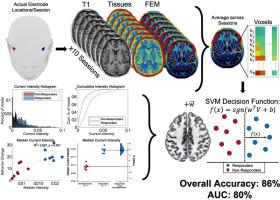当前位置:
X-MOL 学术
›
Brain Stimul.
›
论文详情
Our official English website, www.x-mol.net, welcomes your feedback! (Note: you will need to create a separate account there.)
Machine learning and individual variability in electric field characteristics predict tDCS treatment response
Brain Stimulation ( IF 7.7 ) Pub Date : 2020-11-01 , DOI: 10.1016/j.brs.2020.10.001 Alejandro Albizu , Ruogu Fang , Aprinda Indahlastari , Andrew O’Shea , Skylar E. Stolte , Kyle B. See , Emanuel M. Boutzoukas , Jessica N. Kraft , Nicole R. Nissim , Adam J. Woods
Brain Stimulation ( IF 7.7 ) Pub Date : 2020-11-01 , DOI: 10.1016/j.brs.2020.10.001 Alejandro Albizu , Ruogu Fang , Aprinda Indahlastari , Andrew O’Shea , Skylar E. Stolte , Kyle B. See , Emanuel M. Boutzoukas , Jessica N. Kraft , Nicole R. Nissim , Adam J. Woods

|
Background: Transcranial direct current stimulation (tDCS) is widely investigated as a therapeutic tool to enhance cognitive function in older adults with and without neurodegenerative disease. Prior research demonstrates that electric current delivery to the brain can vary significantly across individuals. Quantification of this variability could enable person-specific optimization of tDCS outcomes. This pilot study used machine learning and MRI-derived electric field models to predict working memory improvements as a proof of concept for precision cognitive intervention. Methods: Fourteen healthy older adults received 20 minutes of 2 mA tDCS stimulation (F3/F4) during a two-week cognitive training intervention. Participants performed an N-back working memory task pre-/post-intervention. MRI-derived current models were passed through a linear Support Vector Machine (SVM) learning algorithm to characterize crucial tDCS current components (intensity and direction) that induced working memory improvements in tDCS responders versus non-responders. Main results: SVM models of tDCS current components had 86% overall accuracy in classifying treatment responders vs. non-responders, with current intensity producing the best overall model differentiating changes in working memory performance. Median current intensity and direction in brain regions near the electrodes were positively related to intervention responses (r = 0:811, p < 0:001 and r = 0:774, p = 0:001). Conclusions: This study provides the first evidence that pattern recognition analyses of MRI-derived tDCS current models can provide individual prognostic classification of tDCS treatment response with 86% accuracy. Individual differences in current intensity and direction play important roles in determining treatment response to tDCS. These findings provide important insights into mechanisms of tDCS response as well as proof of concept for future precision dosing models of tDCS intervention.
中文翻译:

机器学习和电场特性的个体差异预测 tDCS 治疗反应
背景:经颅直流电刺激 (tDCS) 作为一种治疗工具被广泛研究,以增强患有或不患有神经退行性疾病的老年人的认知功能。先前的研究表明,输送到大脑的电流可能因人而异。这种可变性的量化可以实现 tDCS 结果的针对个人的优化。这项试点研究使用机器学习和 MRI 衍生的电场模型来预测工作记忆的改善,作为精确认知干预的概念证明。方法:在为期两周的认知训练干预期间,14 名健康老年人接受了 20 分钟的 2 mA tDCS 刺激 (F3/F4)。参与者在干预前/干预后执行 N-back 工作记忆任务。MRI 衍生的电流模型通过线性支持向量机 (SVM) 学习算法来表征关键的 tDCS 电流分量(强度和方向),这些分量会导致 tDCS 响应者与非响应者的工作记忆改善。主要结果:tDCS 电流分量的 SVM 模型在对治疗反应者与非反应者进行分类时的总体准确度为 86%,电流强度产生了区分工作记忆性能变化的最佳总体模型。电极附近大脑区域的中值电流强度和方向与干预反应呈正相关(r = 0:811,p < 0:001 和 r = 0:774,p = 0:001)。结论:这项研究提供了第一个证据,即 MRI 衍生的 tDCS 当前模型的模式识别分析可以提供 tDCS 治疗反应的个体预后分类,准确度为 86%。电流强度和方向的个体差异在确定对 tDCS 的治疗反应方面起着重要作用。这些发现提供了对 tDCS 反应机制的重要见解,并为未来 tDCS 干预的精确给药模型提供了概念证明。
更新日期:2020-11-01
中文翻译:

机器学习和电场特性的个体差异预测 tDCS 治疗反应
背景:经颅直流电刺激 (tDCS) 作为一种治疗工具被广泛研究,以增强患有或不患有神经退行性疾病的老年人的认知功能。先前的研究表明,输送到大脑的电流可能因人而异。这种可变性的量化可以实现 tDCS 结果的针对个人的优化。这项试点研究使用机器学习和 MRI 衍生的电场模型来预测工作记忆的改善,作为精确认知干预的概念证明。方法:在为期两周的认知训练干预期间,14 名健康老年人接受了 20 分钟的 2 mA tDCS 刺激 (F3/F4)。参与者在干预前/干预后执行 N-back 工作记忆任务。MRI 衍生的电流模型通过线性支持向量机 (SVM) 学习算法来表征关键的 tDCS 电流分量(强度和方向),这些分量会导致 tDCS 响应者与非响应者的工作记忆改善。主要结果:tDCS 电流分量的 SVM 模型在对治疗反应者与非反应者进行分类时的总体准确度为 86%,电流强度产生了区分工作记忆性能变化的最佳总体模型。电极附近大脑区域的中值电流强度和方向与干预反应呈正相关(r = 0:811,p < 0:001 和 r = 0:774,p = 0:001)。结论:这项研究提供了第一个证据,即 MRI 衍生的 tDCS 当前模型的模式识别分析可以提供 tDCS 治疗反应的个体预后分类,准确度为 86%。电流强度和方向的个体差异在确定对 tDCS 的治疗反应方面起着重要作用。这些发现提供了对 tDCS 反应机制的重要见解,并为未来 tDCS 干预的精确给药模型提供了概念证明。



























 京公网安备 11010802027423号
京公网安备 11010802027423号